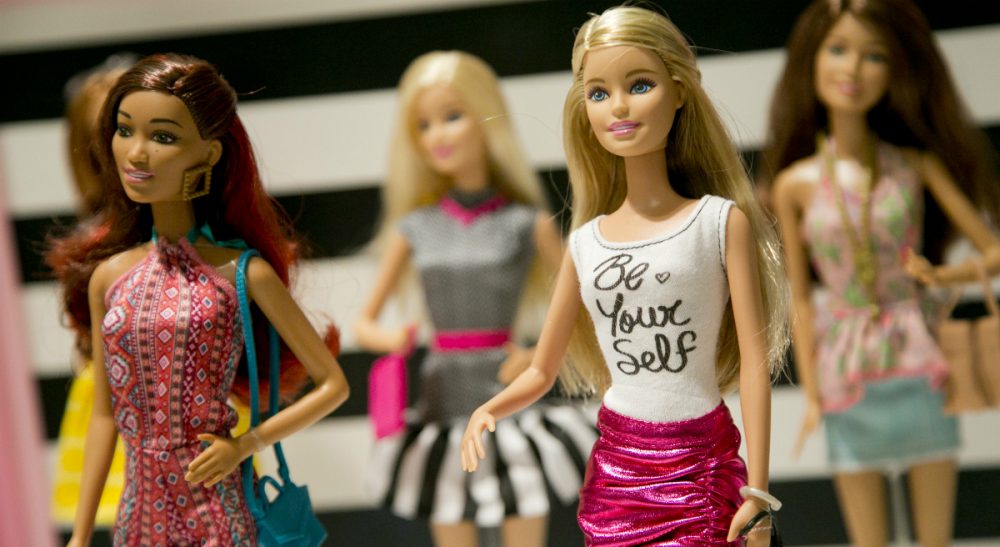Advertisement
With New Body Types, Mattel Expands Barbie's Bottom — And Its Bottom Line

I’d like to think that Mattel’s introduction of three new body types for the iconic Barbie doll — Petite, Curvy and Tall — is the company trying to make amends for the emotional tsunamis thin, busty Barbie has caused over the decades. To further diversify her, Barbie will also come in seven skin tones and sport 24 new hairstyles. There will be a redheaded Barbie, a curly-hair Barbie and even a Barbie with long blue locks. Yet according to a recent Time magazine cover story on Barbie’s transformation, in little girls’ minds, Barbie is still Barbie and they overwhelmingly identify her as blonde and thin.
The cynic in me knows that Barbie’s makeover was mostly a business decision. Barbie, pardon the very bad pun, is a cash cow. According to the Time article, she does a billion dollars in annual sales across more than 150 countries, and 92 percent of American girls ages 3 to 12 have owned a Barbie at some point.
I ... was a short, chubby girl who wouldn’t dare to imagine even coming close to looking like Barbie. It didn’t make me sad exactly, just resigned.
But in the last four years, Barbie has seen her sales lag. In October, Mattel announced a 14 percent global drop in Barbie sales, the eighth consecutive quarter in which profits fell. Barbie’s poor performance is somewhat explained by the fact that Lego has introduced toys aimed at girls who are aspiring engineers and Hasbro has cornered the market on Disney princesses; two years after "Frozen," Elsa continues to be a top moneymaker for the company. Also, figure in the negative impression that many millennial moms have of Barbie.
Barbie and I go way back. She came into my life when I was 6 years old and bedridden for three months. She was a gift from my aunt who also gave me some of Barbie’s exquisite miniature outfits. I went on to collect dresses, bathing suits and my favorite — a bridal gown. I kept Barbie’s clothes in what I thought at the time was the most gorgeous wardrobe in the world — a small black patent leather case with a handle to transport her and her clothes anywhere and everywhere.
Barbie didn’t look like anyone I knew. That was not a surprise considering she had impossible measurements, perfect hair and immaculate makeup. I, on the other hand, was a short, chubby girl who wouldn’t dare to imagine even coming close to looking like Barbie. It didn’t make me sad exactly, just resigned.

Barbie was born fully grown with a checkered past in 1959. She was the invention of Ruth Handler, who named her after her own daughter. Barbie and Handler courted controversy from the beginning when Handler based Barbie’s body on a curvaceous German doll named Lilli. Lilli was often handed out at stag parties as a gag gift. Among Barbie’s other controversies is a book that accompanied her in 1963 entitled, “How to Lose Weight,” which included explicit instructions not to eat. Ten years after playing with my first Barbie, I took that advice and subsisted on Popsicles and saltines for a year.
I have no doubt that I was similar to the subjects in a comprehensive 2006 study of young girls 5 to 8. Researchers found that “early exposure to dolls epitomizing an unrealistically thin body ideal may damage girls’ body image, which would contribute to an increased risk of disordered eating and weight cycling."
Bingo.
Barbie’s body transformation comes on the heels of a chameleon life in which she has had over a hundred careers ranging from rock star to presidential candidate. She’s been a medic in Operation Desert Storm. She’s been black, Hispanic and even a devout Jew. But after all these years, I still don’t see myself in any of those versions of Barbie. Like the little girls who test drove these new Barbies, I still identify her tiny waist and her perfectly coiffed blonde tresses as hallmarks of the Barbie I know.
And the new Barbies will not pierce her plastic mask of perfection. She still has no paunch, no wrinkles and no thick ankles. Damn her!
And the new Barbies will not pierce her plastic mask of perfection. She still has no paunch, no wrinkles and no thick ankles. Damn her! Only her wide hips constitute body diversity — hips that are the norm for most women. A number of commentators have noted that Barbie’s feet have finally been leveled off so she can now wear flats as well as stilettos. No doubt that will add to the over one billion pairs of shoes she has owned.
I imagine a day when we’ll see Barbie in a wheelchair, or using a walker, or walking on a prosthetic leg. But I suspect she’ll never need a hearing aid or an insulin pump. Her hair, all 24 versions of it, will never frizz. She will never have a pimple or even a freckle. Despite all the angst she’s caused, she remains maddeningly aloof. And she reminds us that women will always find something wrong with their bodies.
